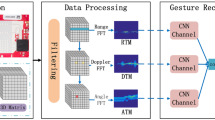Abstract
This paper presents a multi-recursive wavelet neural network (MRWNN) with proximity capacitive gesture recognition. Recently, the capacitive sensor technologies have been developed for proximity methods that sensing electronic varies around sensor detection point, but the user gesture signals are time-variant. The MRWNN have multi layers recursive weight to record last signal variation, and we utilize microcontroller with MRWNN to identify algorithms and implement proximity capacitive gesture recognition. Moreover, we show MRWNN weight convergence analysis of the MRWNN signal identifier. In the experimental results, we show MRWNN can recognize patterns of different gesture signal accurately and reliably. In addition, we use wearable device combined with BLE (Bluetooth Low Energy) feedback output response immediately.
Access this chapter
Tax calculation will be finalised at checkout
Purchases are for personal use only
Similar content being viewed by others
References
Lin, X., Adhikary, A., Wang, Y.P.E.: Random access preamble design and detection for 3GPP narrowband IoT systems. IEEE Wirel. Commun. Lett. 5(6), 640–643 (2016)
Chu, C.T., Chiang, H.K., Hung, J.J.: Dynamic heart rate monitors algorithm for reflection green light wearable device. In: International Conference on Intelligent Informatics and Biomedical Sciences, vol. 62, no. 8, pp. 438–445 (2015)
Ha, U., Lee, Y., Kim, H.T., Roh, J., Kim, B.C., Yoo, H.J.: A Wearable EEG-HEG-HRV multimodal system with simultaneous monitoring of tES for mental health management. IEEE Trans. Biomed. Circuits Syst. 9(6), 758–766 (2015)
Brugarolas, R., et al.: Wearable heart rate sensor systems for wireless canine health monitoring. IEEE Sens. J. 16(10), 3454–3464 (2016)
Wiens, A.D., Etemadi, M., Roy, S., Klein, L., Inan, O.T.: Toward continuous, noninvasive assessment of ventricular function and hemodynamics: wearable ballistocardiography. IEEE J. Biomed. Health Inform. 22(1), 1435–1442 (2015)
Semnani, S.H., Basir, O.A.: Semi-flocking algorithm for motion control of mobile sensors in large-scale surveillance systems. IEEE Trans. Cybern. 45(1), 129–137 (2015)
Fazio, M., Puliafito, A.: Cloud4sens: a cloud-based architecture for sensor controlling and monitoring. IEEE Commun. Mag. 41(47), 4–8 (2015)
Kafi, M.A., Djenouri, D., Othman, J.B., Badache, N.: Congestion control protocols in wireless sensor networks: a survey, and future trends. IEEE Commun. Surv. Tutor. 16(3), 1369–1390 (2014)
Giles, C.L., Miller, C.B., Chen, D., Chen, H.H., Sun, G.Z., Lee, Y.C.: Learning and extracting finite state automata with second-order recurrent neural networks. Neural Comput. 4(3), 518–527 (1992)
Kim, Y., Moon, T.: Human detection and activity classification based on micro-doppler signatures using deep convolutional neural networks. IEEE Trans. Ind. Electron. 13(1), 8–12 (2016)
Bu, N., Okamoto, M., Tsuji, T.: A hybrid motion classification approach for EMG-based human–robot interfaces using bayesian and neural networks. IEEE Trans. Rob. 25(3), 502–511 (2009)
Gupta, H.P., Chudgar, H.S., Mukherjee, S., Dutta, T.: A continuous hand gestures recognition technique for human-machine interaction using accelerometer and gyroscope sensors. IEEE Sens. J. 16(16), 6425–6432 (2016)
Chang, J.Y.: Nonparametric feature matching based conditional random fields for gesture recognition from multi-modal video. IEEE Trans. Pattern Anal. Mach. Intell. 38(8), 1612–1625 (2016)
Lefter, I., Burghouts, G.J., Rothkrantz, L.J.M.: Recognizing stress using semantics and modulation of speech and gestures. IEEE Trans. Affect. Comput. 38(8), 162–175 (2017)
Acknowledgment
This work was supported in part by the “Intelligent Recognition Industry Service Center” of Higher Education Sprout Project, Ministry of Education, Taiwan.
Author information
Authors and Affiliations
Corresponding author
Editor information
Editors and Affiliations
Rights and permissions
Copyright information
© 2019 Springer Nature Singapore Pte Ltd.
About this paper
Cite this paper
Chu, CT., Ho, CC. (2019). Multi-recursive Wavelet Neural Network for Proximity Capacitive Gesture Recognition Analysis and Implementation. In: Chang, CY., Lin, CC., Lin, HH. (eds) New Trends in Computer Technologies and Applications. ICS 2018. Communications in Computer and Information Science, vol 1013. Springer, Singapore. https://doi.org/10.1007/978-981-13-9190-3_53
Download citation
DOI: https://doi.org/10.1007/978-981-13-9190-3_53
Published:
Publisher Name: Springer, Singapore
Print ISBN: 978-981-13-9189-7
Online ISBN: 978-981-13-9190-3
eBook Packages: Computer ScienceComputer Science (R0)




